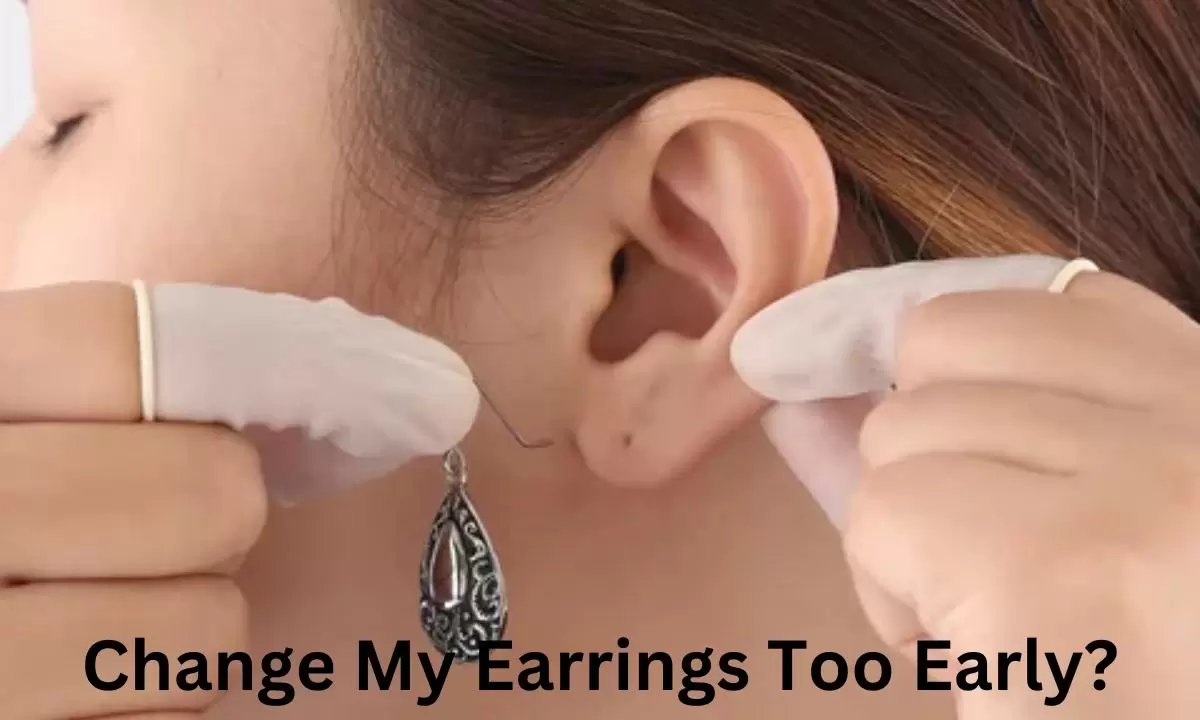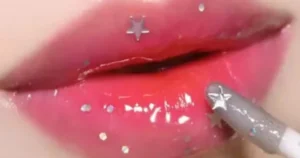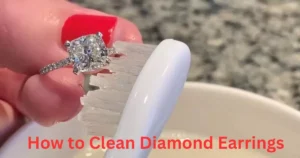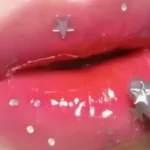Changing earrings too early after getting a new piercing can have serious consequences. Introducing new jewelry before the piercing has fully healed can disrupt the healing process, increase the risk of infection, cause irritation and inflammation, and potentially lead to complications such as scarring, keloid formation, or even deformity of the piercing site.
The delicate healing tissue can tear or become damaged when earrings are forcefully removed or inserted prematurely, prolonging the overall healing time and potentially compromising the health and appearance of the piercing. It’s crucial to exercise patience and follow the recommended waiting periods, typically 6-8 weeks for earlobe piercings and 3-6 months or longer for cartilage piercings, to allow the piercing to heal properly and minimize the risk of complications.
How long to wait before changing earrings after piercing?
When you get a new ear piercing, it’s essential to wait an appropriate amount of time before changing your earrings. The recommended waiting period varies depending on the type of piercing, but generally, you should avoid changing your earrings too early to prevent complications and ensure proper healing.
For earlobe piercings, it’s typically recommended to wait 6-8 weeks before changing the initial earrings. However, for cartilage piercings, such as helix or tragus piercings, the healing time can be longer, ranging from 3-6 months or even up to a year in some cases.
Factors that affect the healing time of a new piercing
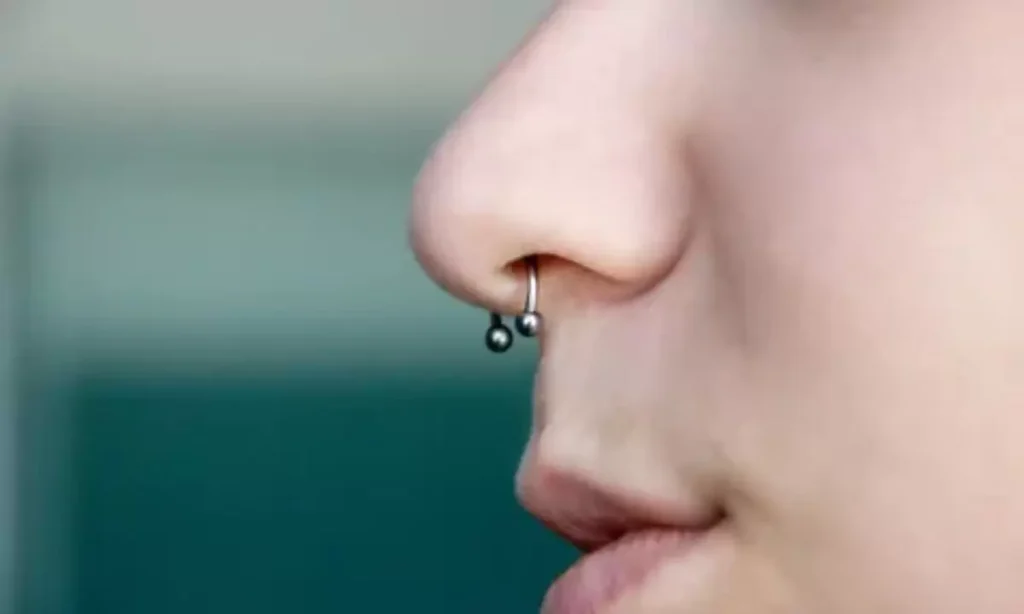
Several factors can influence the healing time of a new piercing, including:
- Location of the piercing: Piercings in areas with more cartilage, such as the helix or tragus, tend to take longer to heal than earlobe piercings.
- Individual healing ability: Some people’s bodies heal faster or slower than others due to various factors like age, overall health, and immune system function.
- Aftercare: Proper aftercare, including cleaning the piercing regularly and avoiding irritation, can significantly impact the healing process.
- Jewelry material: High-quality jewelry made of materials like surgical-grade stainless steel, titanium, or gold is less likely to cause irritation and promote faster healing.
The best types of earrings to wear during the healing process
During the healing phase, it’s crucial to wear appropriate earrings that won’t irritate the new piercing or delay the healing process. Here are some recommended options:
- Surgical-grade stainless steel studs: Stainless steel is a popular choice as it’s hypoallergenic, durable, and easy to keep clean.
- Titanium labrets or barbells: Titanium is another excellent option for those with metal sensitivities, as it’s highly biocompatible and resistant to corrosion.
- Implant-grade PTFE (Teflon) labrets: These are ideal for those with metal allergies or sensitivities, as they are entirely metal-free.
Avoid earrings made of low-quality metals, such as nickel or costume jewelry, as these can cause irritation and delay healing.
How to take care of your new piercing
Proper aftercare is essential for ensuring a smooth healing process and preventing complications. Here are some tips for taking care of your new piercing:
- Clean the piercing twice a day: Use a saline solution or a gentle, fragrance-free soap and warm water to clean the area around the piercing.
- Avoid touching or playing with the piercing: This can introduce bacteria and delay healing.
- Protect the piercing: Avoid sleeping on the pierced side, and be careful when changing clothes or toweling off after a shower.
- Avoid swimming or submerging the piercing: Bodies of water, such as pools or hot tubs, can harbor harmful bacteria that can cause infections.
- Eat a balanced diet and stay hydrated: Proper nutrition and hydration can support the healing process.
Signs of infection to watch out for piercing
While some redness, swelling, and minor discomfort are normal during the healing process, you should watch out for signs of infection, which may include:
- Excessive swelling, redness, or warmth around the piercing site
- Yellow or green discharge
- Severe pain or tenderness
- Fever or chills
If you experience any of these symptoms, seek medical attention promptly, as an infection can lead to complications if left untreated.
When to seek medical attention for your piercing
In addition to signs of infection, you should seek medical attention if you experience any of the following:
- Severe bleeding that doesn’t stop
- The jewelry becomes embedded or stuck in the piercing
- The piercing hasn’t shown signs of healing after several months
- You develop an allergic reaction or severe irritation
Your piercer or healthcare provider can assess the situation and provide appropriate treatment or advice.
Can you change earrings earlier than the recommended waiting time?
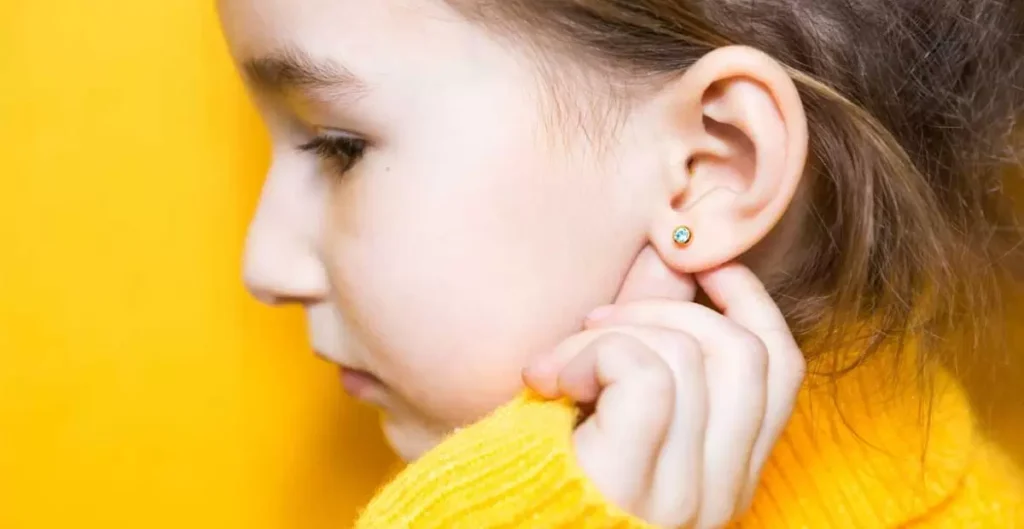
While it’s generally not recommended to change your earrings before the recommended waiting period, some people may be tempted to do so for various reasons, such as attending a special event or switching to a different style.
It’s important to note that changing your earrings too early can disrupt the healing process and increase the risk of complications, such as:
- Irritation or inflammation
- Tearing or damage to the piercing channel
- Increased risk of infection
- Prolonged healing time
If you absolutely must change your earrings before the recommended waiting period, it’s crucial to consult with a professional piercer or your healthcare provider first. They can assess the healing progress and provide guidance on whether it’s safe to do so.
What happens if you change earrings too soon?
Changing your earrings too soon, before the piercing has fully healed, can lead to several potential complications:
- Irritation and inflammation: Introducing new jewelry too early can cause irritation and inflammation around the piercing site, hindering the healing process and potentially leading to complications like scarring or keloid formation.
- Tearing or damage: Removing or inserting earrings before the piercing channel has fully formed can cause tearing or damage to the delicate healing tissue, increasing the risk of infection and prolonging the healing time.
- Infection: New piercings are susceptible to infection, and changing the jewelry too soon can introduce bacteria into the open wound, increasing the risk of developing an infection.
- Prolonged healing time: Disrupting the healing process by changing earrings too early can significantly prolong the overall healing time, as the body will need to start the healing process anew.
- Scarring or deformity: In severe cases, changing earrings too soon can lead to scarring, keloid formation, or even deformity of the piercing site, particularly in areas with cartilage.
It’s essential to exercise patience and follow the recommended waiting periods to ensure a smooth healing process and minimize the risk of complications.
How to change earrings safely after piercing
Once your piercing has fully healed and you’re ready to change your earrings, it’s important to follow proper hygiene and safety protocols to avoid complications. Here are some tips for changing your earrings safely:
- Wash your hands thoroughly: Clean your hands with soap and warm water, or use an alcohol-based hand sanitizer to minimize the risk of introducing bacteria.
- Sterilize the new jewelry: Clean the new earrings with a safe disinfectant or sterilization solution before inserting them into your piercing.
- Remove the old earrings carefully: Gently twist and remove the old earrings, being careful not to cause any trauma or damage to the piercing channel.
- Insert the new earrings properly: Insert the new earrings following the same angle and direction as the previous ones, being gentle and avoiding any forceful movements.
- Clean the area: Once the new earrings are in place, clean the area around the piercing with a saline solution or mild soap and warm water to remove any debris or discharge.
- Monitor for signs of irritation or infection: Observe the piercing site for any signs of irritation, redness, swelling, or discharge in the days following the jewelry change. If any issues arise, seek medical attention promptly.
It’s also a good idea to consult with a professional piercer or your healthcare provider if you have any concerns or questions about changing your earrings safely.
Premature Earring Change Affect Ear Health
Changing earrings too soon after getting a new piercing can have several negative impacts on ear health. Here are some potential consequences:
- Increased risk of infection: New piercings are essentially open wounds, and introducing new jewelry before they have fully healed can introduce bacteria and increase the risk of developing an infection. Infections can lead to complications like swelling, discharge, and even the formation of abscesses if left untreated.
- Delayed healing: Changing earrings prematurely disrupts the healing process and can cause the piercing to essentially start healing from the beginning again. This can significantly delay the overall healing time, leading to prolonged discomfort and increased risk of complications.
- Tissue damage and scarring: Removing or inserting earrings before the piercing channel has fully formed can cause trauma and damage to the delicate healing tissue. This can lead to scarring, keloid formation, or even deformity of the piercing site, particularly in areas with cartilage.
- Increased pain and discomfort: Changing earrings too soon can cause unnecessary pain and discomfort, as the piercing site is still in the process of healing and may be tender or
Common Complications Of Early Earring Replacement
Changing earrings before the recommended waiting period can lead to various complications, some of which can be serious if left untreated. Here are some common complications associated with premature earring replacement:
- Infection: Introducing new jewelry before the piercing has fully healed increases the risk of bacterial infection. Signs of infection include:
- Excessive redness, swelling, and warmth around the piercing site
- Oozing of yellow or green discharge
- Severe pain or tenderness
- Fever or chills
- Irritation and inflammation: New jewelry can cause irritation and inflammation, leading to redness, swelling, and discomfort around the piercing site.
- Tearing or trauma: Forcefully removing or inserting earrings before the piercing channel has fully formed can cause tearing or trauma to the delicate healing tissue.
- Migration or rejection: Changing earrings too soon can disrupt the healing process and cause the piercing to migrate or become rejected by the body.
- Keloid formation: In some individuals, premature earring changes can trigger the formation of keloids, which are raised, fibrous scars that can be unsightly and difficult to treat.
- Prolonged healing time: Disrupting the healing process by changing earrings too early can significantly prolong the overall healing time, as the body will need to start the healing process anew.
- Scarring or deformity: In severe cases, changing earrings too soon can lead to scarring, keloid formation, or even deformity of the piercing site, particularly in areas with cartilage.
It’s crucial to follow the recommended waiting periods and consult with a professional piercer or healthcare provider if you experience any complications or have concerns about changing your earrings.
Important To Wait Before Changing Earrings

Waiting the recommended time before changing earrings after getting a new piercing is crucial for several reasons:
- Allows proper healing: The healing process for a new piercing takes time, and changing the earrings too soon can disrupt this process and delay healing.
- Prevents infection: New piercings are essentially open wounds, and introducing new jewelry before they have fully healed can increase the risk of infection by introducing bacteria.
- Avoids irritation and inflammation: Changing earrings prematurely can cause irritation and inflammation around the piercing site, leading to discomfort and potential complications.
- Minimizes trauma: Removing or inserting earrings before the piercing channel has fully formed can cause trauma and damage to the delicate healing tissue, potentially leading to scarring or deformity.
- Reduces the risk of migration or rejection: Disrupting the healing process by changing earrings too early can cause the piercing to migrate or become rejected by the body.
- Promotes proper healing: Following the recommended waiting period allows the piercing to heal correctly, reducing the risk of complications and ensuring a healthy, well-healed piercing.
It’s important to exercise patience and follow the advice of a professional piercer or healthcare provider regarding the appropriate waiting time for your specific piercing. Rushing the process can lead to various complications and potentially compromise the overall health and appearance of your piercing.
How Long After Ear Piercing Can You Change Earrings ?
The recommended waiting period before changing earrings after getting a new piercing varies depending on the type of piercing and the individual’s healing process. Here are some general guidelines:
- Earlobe piercings: For standard earlobe piercings, it’s typically recommended to wait 6-8 weeks before changing the initial earrings. This allows sufficient time for the piercing to heal and form a sturdy channel.
- Cartilage piercings: Piercings in the cartilage areas of the ear, such as the helix, tragus, or daith, generally take longer to heal. The recommended waiting period for these piercings is typically 3-6 months or even up to a year in some cases.
- Industrial piercings: Industrial piercings, which involve two separate piercings connected by a single piece of jewelry, can take up to 6-12 months to fully heal. It’s best to wait at least 6 months before changing the jewelry.
- Nose piercings: For nostril piercings, the recommended waiting period is typically 2-3 months before changing the initial jewelry.
It’s important to note that these are general guidelines, and individual healing times can vary. Factors such as age, overall health, aftercare practices, and individual healing abilities can affect the healing process.
If you’re unsure about when to change your earrings, it’s always best to consult with a professional piercer or your healthcare provider. They can assess the healing progress and provide personalized advice based on your specific situation.
How To Style Earrings For A Formal Event ?
Styling earrings for a formal event requires careful consideration to ensure they complement your overall look while adhering to the dress code. Here are some tips for styling earrings for a formal occasion:
- Choose classic and elegant styles: For formal events, it’s best to opt for classic and elegant earring styles that don’t overpower your outfit. Simple studs, drops, or chandeliers in precious metals like gold or platinum are excellent choices.
- Consider the neckline: The neckline of your dress or top should guide your earring choice. For example, studs or small drops work well with high necklines, while longer dangle or chandelier earrings complement lower necklines.
- Match metals: Ensure that the metal of your earrings matches the other jewelry pieces you plan to wear, such as a necklace or bracelet. This creates a cohesive and polished look.
- Incorporate gemstones or pearls: Earrings with gemstones or pearls can add a touch of elegance and sophistication to your formal ensemble. Choose stones that complement the colors of your outfit or opt for classic pearls for a timeless look.
- Consider your hairstyle: If you plan to wear your hair up, larger or more statement earrings can be a beautiful focal point. If you’re wearing your hair down, smaller or more delicate earrings may be more appropriate.
- Avoid overly trendy or casual styles: While trendy or casual earring styles may be appropriate for everyday wear, formal events call for more timeless and sophisticated pieces.
- Accessorize with care: If you’re wearing a bold necklace or other statement jewelry pieces, opt for more understated earrings to avoid overwhelming your look.
Remember, the key to styling earrings for a formal event is to strike a balance between elegance, sophistication, and complementing your overall outfit. Don’t be afraid to experiment and find the perfect earrings that make you feel confident and stylish.
Professional Advice For Specific Piercings Earrings
When it comes to choosing earrings for specific piercings, it’s essential to consider the type of piercing, the shape of your ear, and the overall look you’re trying to achieve. Here’s some professional advice for various types of piercings:
- Earlobe piercings:
- For standard earlobe piercings, studs or small hoops are classic choices.
- Consider your face shape when choosing earring styles. Round faces often look best with studs or drop earrings, while oval or heart-shaped faces can wear a variety of styles.
- Opt for lightweight materials like gold, silver, or platinum to avoid stretching the piercing.
- Cartilage piercings (helix, tragus, daith):
- For cartilage piercings, studs or small hoops are recommended, as larger or heavier earrings can put pressure on the piercing and delay healing.
- Use high-quality metals like surgical steel, titanium, or 14k gold to minimize the risk of irritation or allergic reactions.
- Consider the angle and location of the piercing when choosing earring styles. For example, a curved barbell may work better for a daith piercing than a straight one.
- Industrial piercings:
- Industrial piercings require a specific barbell-style piece of jewelry that connects two piercings in the upper ear cartilage.
- Opt for high-quality, implant-grade materials like titanium or PTFE (Teflon) to minimize the risk of complications.
- Avoid changing the jewelry too frequently, as industrial piercings can take up to a year to fully heal.
- Nose piercings:
- For nostril piercings, consider the size and shape of your nose when choosing jewelry. Smaller studs or nosescrews may be more flattering on petite noses, while larger hoops or rings can
What Are Some Affordable Earring Options For Everyday Wear?
While some may associate earrings with luxury and expensive gemstones, there are plenty of affordable options available for everyday wear that don’t sacrifice style or quality. Here are some budget-friendly earring choices to consider:
- Stainless steel studs: Stainless steel is an excellent option for those with sensitive skin or metal allergies. You can find a variety of styles, from simple ball studs to cubic zirconia-encrusted designs, at affordable prices.
- Sterling silver hoops: Classic sterling silver hoops are versatile and can dress up or down any outfit. Look for thin, lightweight options that won’t stretch your piercings over time.
- Acrylic or resin earrings: Acrylic and resin earrings come in a wide range of colors, shapes, and patterns, making them a fun and affordable way to experiment with different styles. They’re also lightweight and suitable for those with metal allergies.
- Wooden earrings: For a natural and bohemian look, consider wooden earrings. They’re usually inexpensive and come in various shapes, from simple studs to intricate dangle designs.
- Faux pearl studs: Pearls are a timeless and elegant choice, but real pearls can be costly. Opt for faux pearl studs for a similar look at a fraction of the price.
- Enamel or ceramic studs: Enamel and ceramic earrings offer a pop of color and can be found in various shapes and designs, from simple circles to intricate patterns.
- Beaded earrings: Beaded earrings are versatile and can range from casual to dressy, depending on the materials used. Look for options made with wood, glass, or plastic beads for an affordable yet stylish option.
- Vintage or secondhand finds: Check out local thrift stores, vintage shops, or online marketplaces for unique and affordable earring finds. You may stumble upon hidden gems at a fraction of their original cost.
When shopping for affordable earrings, look for high-quality materials like surgical steel, titanium, or hypoallergenic plastics to avoid irritation or allergic reactions. Additionally, ensure that the earrings are securely fastened and won’t fall out easily during everyday wear.
How To Accessorize Earrings With Different Outfits?
Earrings can be a powerful accessory that can elevate and complement any outfit. However, it’s essential to know how to accessorize them properly to create a cohesive and stylish look. Here are some tips on how to accessorize earrings with different outfits:
- Casual outfits:
- For a casual, laid-back look, opt for simple stud earrings or small hoops in metals like gold, silver, or rose gold.
- You can also experiment with colorful or funky earrings, like acrylic or resin designs, to add a playful touch to your outfit.
- Office or professional attire:
- When dressing for the office or a professional setting, choose classic and understated earrings that won’t distract from your overall look.
- Pearls, diamond studs, or small hoops in precious metals are excellent choices.
- Avoid overly large or dangly earrings, as they can appear too casual or distracting.
- Evening or formal wear:
- For formal occasions or evening events, opt for statement earrings that will complement your outfit.
- Chandelier earrings, oversized hoops, or dangle earrings with gemstones or crystals can add glamour and sophistication to your look.
- Ensure that your earrings don’t clash with your neckline or other jewelry pieces.
- Bohemian or ethnic styles:
- For a boho-chic or ethnic-inspired outfit, accessorize with earrings that have a natural or handmade feel.
- Consider earrings made with materials like wood, beads, or feathers.
- Tassel or fringe earrings can also complement these styles beautifully.
- Coordinate with your outfit:
- Try to coordinate your earrings with the colors or patterns in your outfit for a cohesive look.
- For example, if you’re wearing a floral dress, you could accessorize with earrings that feature floral motifs or colors that complement the dress.
Remember, the key to accessorizing earrings is to strike a balance between the earrings and your overall outfit. Don’t let your earrings overpower or clash with the rest of your look. Experiment with different styles and have fun with your accessories!
What Are Some Tips For Finding The Right Size Earrings For Your Face?
Choosing the right size earrings can make a significant difference in framing and enhancing your facial features. Here are some tips for finding the ideal earring size for your face:
- Consider your face shape:
- For round faces, opt for longer, dangle earrings that elongate the face.
- If you have an oval face, you can pull off a variety of earring styles and sizes.
- For square or heart-shaped faces, round or teardrop-shaped earrings can soften the angular features.
- Those with long or rectangular faces should consider wider or chandelier-style earrings to add width and balance.
- Pay attention to your ear size:
- If you have smaller ears, avoid oversized or heavy earrings that can overwhelm your features.
- Larger ears can accommodate bigger earrings, but be mindful of proportions to avoid looking unbalanced.
- Consider your hair length and style:
- If you have shorter hair or wear your hair up frequently, larger or more statement earrings can be a beautiful focal point.
- For longer hairstyles, smaller or medium-sized earrings may be more appropriate to avoid competing with your hair.
- Experiment with different earring lengths:
- For stud earrings, choose a size that complements your earlobe without appearing too small or too large.
- For dangle or drop earrings, consider the length in relation to your face shape and neck length. Aim for a length that falls between your jawline and shoulder for a flattering look.
- Consider your lifestyle and occasion:
- For everyday wear, opt for smaller, more practical earrings that won’t get in the way or catch on clothing.
- For formal or special occasions, you can go for larger, more statement earrings that make a bold fashion statement.
- Try them on and assess the proportions:
- The best way to determine the right earring size is to try different options and assess how they look on your face.
Conclusion
exercising patience and following the recommended waiting periods before changing earrings after a new piercing is absolutely essential. Rushing to switch out jewelry too soon can severely disrupt the healing process and lead to infections, irritation, scarring, and other complications that can compromise both the health and appearance of your new piercing.
By allowing sufficient time for the piercing to fully heal and being gentle when finally changing your earrings, you give your piercing the best chance to look and feel its best for years to come. A little extra care and caution in those critical first few weeks and months is a small price to pay for a lifetime of enjoyment from your body piercing.
Trust the guidance of professional piercers and your own intuition – when in doubt, it’s always better to wait a bit longer before changing your earrings.
